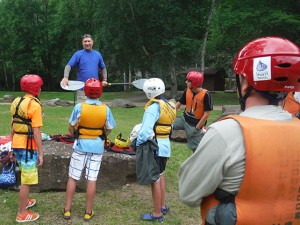Boy Scouts of America Kayaking Merit Badge Program:
Learn kayaking with safety as the first priority.

Kayak Merit Badge
Boy Scouts can earn all of the requirements for the Kayaking Merit Badge (with the exception of the swimming skills.) The paddling day will focus on providing Scouts the opportunity to complete the requirements for the merit badge including; equipment, stokes, and on the water skills.
Scouts will learn the different parts of the kayak and paddle. The teamwork aspect of enjoying a safe climbing experience are reinforced throughout the day. Rating systems and equipment care are also covered in the class.
Kayak Instruction Course Covers
- Proper sizing a boat and paddle, paddling strokes
- River hazards
- Belaying and backup belaying
- Rappel instruction: equipment, fireman’s backup belay, techniques
- Rappelling on vertical and over-hanging rock faces using various rappel devices
We Provide
Kayaks, Paddles and Life jackets,
Cost
$60.00/person
ages 12 and up
- Do the following:
- Explain to your counselor the most likely hazards you may encounter while participating in kayaking activities, including weather and water-related hazards, and what you should do to anticipate, help prevent, mitigate, and respond to these hazards.
- Review prevention, symptoms, and first-aid treatment for the following injuries or illnesses that can occur while kayaking: blisters, cold-water shock and hypothermia, heat-related illnesses, dehydration, sunburn, sprains, and strains.
- Review the BSA Safety Afloat policy. Explain to your counselor how this applies to kayaking activities.
- Before doing requirements 3 through 9, successfully complete the BSA swimmer test: Jump feet first into water over the head in depth. Level off and swim 75 yards in a strong manner using one or more of the following strokes: sidestroke, breaststroke, trudgen, or crawl; then swim 25 yards using an easy, resting backstroke. The 100 yards must be completed in one swim without stops and must include at least one sharp turn. After completing the swim, rest by floating.
- Do the following:
- Review the characteristics of life jackets most appropriate for kayaking and why one must always be worn while paddling. Then demonstrate how to select and fit a life jacket for kayaking.
- Review the importance of safety equipment such as a signal device, air flotation bags, extra paddle, sponge, bilge pump, rescue sling, and throw bag.
- Do the following:
- Name and point out the major parts of a kayak.
- Review the differences in the design between recreational, whitewater, and sea or touring kayaks. Include how length, width, stability, and rocker are involved in the design of each type.
- Review the advantages and disadvantages of the materials most commonly used to make kayaks. Explain the care, maintenance, and storage of a kayak.
- Using the trucker’s hitch and bowline, demonstrate how to secure a kayak to a rack on a vehicle or a trailer, or to a rack on land.
- Discuss the following:
- How to choose a kayak paddle
- The different materials from which paddles are made, parts of a paddle, and the care and maintenance of a paddle
- Using a properly equipped kayak with an open cockpit, a sit-on-top, or an inflatable kayak, do the following:
- Safely capsize and perform a wet exit.
- Reenter the kayak with assistance from a buddy boat.
- Demonstrate a kayak-over-kayak rescue.
- Demonstrate the HELP position.
- Capsize the kayak, swim it, and then paddle to shore, and empty water from the kayak with assistance if needed.
- As a solo paddler, use a properly equipped kayak to demonstrate the following:
- Forward stroke
- Backstroke
- Forward sweep
- Reverse sweep
- Draw stroke
- Stern draw
- As a solo paddler, use a properly equipped kayak to demonstrate the following:
- Paddle a straight line for 25 yards, make a sharp turn, and return 25 yards in a straight line.
- Spin or pivot 360 degrees to the right and 360 degrees to the left.
- Move abeam to the right 10 feet and to the left 10 feet.
- Stop the boat in one boat length.
- Paddle a buoyed course of a length determined by your counselor that includes two right and two left turns performed while underway.



